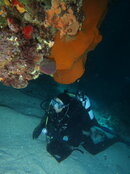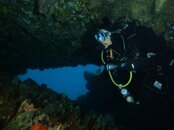95% of my diving has been solo dating back to 1961-62. Personally, I wouldn't venture into a true hard overhead environment solo even with my redundant gear... but then I would most likely not do it with a trained buddy either. Caves are just not my thing (especially if they are fresh water), but of course your mileage does vary and that's fine with me.
You are using an out of date browser. It may not display this or other websites correctly.
You should upgrade or use an alternative browser.
You should upgrade or use an alternative browser.
No solo diving in overhead environment
- Thread starter Foxfish
- Start date
Please register or login
Welcome to ScubaBoard, the world's largest scuba diving community. Registration is not required to read the forums, but we encourage you to join. Joining has its benefits and enables you to participate in the discussions.
Benefits of registering include
- Ability to post and comment on topics and discussions.
- A Free photo gallery to share your dive photos with the world.
- You can make this box go away
95% of my diving has been solo dating back to 1961-62. Personally, I wouldn't venture into a true hard overhead environment solo even with my redundant gear... but then I would most likely not do it with a trained buddy either. Caves are just not my thing (especially if they are fresh water), but of course your mileage does vary and that's fine with me.
Maybe give it a try if you're ever over this way.
Attachments
mick allein III
Contributor
Foxfish in reading your posts you strike me as an intelligent, thoughtful diver. Looking at your profile, we have similar certifications and experiences. I'm not one to bow to the agency gods and collect every c card imaginable, but like you I recently took the SDI Solo course with a good instructor. (He also taught cave and wreck diving). He was adamant about not entering overhead environments ( even simple swim thrus) solo. I've heeded the advice. In my diving experience, I'm always struck by what simple things can go wrong underwater. I remember swimming by the remnants of a dangling rope tied off a submerged boat, I remember thinking that I should swim well above and away from it, but thought the chances of getting entangled were very slim. It got me right along my tank valve. Not realizing it I kept finning. As it tightened I went vertical kicking silt everywhere. In seconds I was caught in zero viz. To add to it I was pushing my air and was at about 500PSI. Stupid sh*t all in a very simple Midwest quarry. Now there are lots of "simple" swim thrus in the quarries around here. I can't imagine having any problem swimming thru these solo. But I remind myself of that weird stuff happens underwater and it can be an unforgiving place. Dive safe brother.
Sent from my iPhone using Tapatalk
Sent from my iPhone using Tapatalk
Foxfish in reading your posts you strike me as an intelligent, thoughtful diver. Looking at your profile, we have similar certifications and experiences. I'm not one to bow to the agency gods and collect every c card imaginable, but like you I recently took the SDI Solo course with a good instructor. (He also taught cave and wreck diving). He was adamant about not entering overhead environments ( even simple swim thrus) solo. I've heeded the advice. In my diving experience, I'm always struck by what simple things can go wrong underwater. I remember swimming by the remnants of a dangling rope tied off a submerged boat, I remember thinking that I should swim well above and away from it, but thought the chances of getting entangled were very slim. It got me right along my tank valve. Not realizing it I kept finning. As it tightened I went vertical kicking silt everywhere. In seconds I was caught in zero viz. To add to it I was pushing my air and was at about 500PSI. Stupid sh*t all in a very simple Midwest quarry. Now there are lots of "simple" swim thrus in the quarries around here. I can't imagine having any problem swimming thru these solo. But I remind myself of that weird stuff happens underwater and it can be an unforgiving place. Dive safe brother.
Sent from my iPhone using Tapatalk
Thanks mate. I can see you're genuinely concerned and trying to help. The funny thing is that I've been diving these caverns and swim throughs for years and never given it a second though. Apart from keeping OW divers out on a technicality no one has ever suggested it was unsafe. At the same time I cringe at the risks involved with wreck and cave diving.
I think a lot of the problem is understanding the different contexts in which we dive. Our caverns/swim throughs are predominantly large limestone formations. The bottom of the caverns is either course white sand or limestone and it simply does not silt up in the way you suggested. You may be able to get a concept of the sand from the photo below.
I'll keep an open mind. It will be interesting to hear what they have to say about it on the course.

mick allein III
Contributor
Beautiful! Nothing like that in the Midwest quarries. I'll be interested in your posts following the course. Let us know how it turns out.
Sent from my iPhone using Tapatalk
Sent from my iPhone using Tapatalk
The last wreck course I taught was this summer. On the last two dives of the six dive course I had the student experience an entanglement in the open and in a wide open multiple exit overhead. Some would call it a benign swim thru. He did as well. Until after the dive. Using #18 line I had him swim past it in open water. It snagged his valve and fin buckle. He got three kicks before he even realized he was caught. Now he knew this was going to happen so once he stopped he turned slowly. Had he turned quickly it could have wrapped him up pretty well. This was line he could see. Monofilament line can nearly be invisible. Especially in low vis. And wrecks attract fish, which attract fishermen, who use mono line and leave it.
The next scenario was a spider web I set up in the "swim thru" as might be encountered by one where line drifted into the wreck or slob divers who did not know how to run line and retrieve it just left it. He got snagged and was able to free himself. Then he helped me get free after I "panicked" and did a demo of a diver finding himself snagged and not reacting slowly. I looked like Frodo in Shelob's web. But he reacted as he was trained to get me "calmed" and free me. We then cleaned up the space and went on our way.
What impressed him the most was not the way I strung the line or how easy it was to get free by acting slowly and with thought. What made the biggest impression was how long it took for him to realize he was hung up. He admitted to expecting a sudden jerk and be brought up short. But it did not happen. It was gentle and almost imperceptible until he was caught solidly. And that is one of the biggest lessons I think. You don't know how bad it is until it happens and is bad. A benign looking place, coupled with poor training and lack of emphasis on real risks. I think this has played a hand in a number of fatalities. How else can you explain the seemingly complete lack of common sense in divers that follow a guide into some of these places with fatal results?
Where this gets bad is that now these same people can take a course or courses that give them access to sites that pose more risk. And even though the new instructor really gets it and tells them the unvarnished truth about risk and how dangerous it is, they have been tainted. Their previous experience says "They told us about this being bad and that being bad in the OW class then that guide took us through the Devils Throat and nothing happened." I have to think that those types of things stay in the back of a divers mind and have an influence on any further training. It pollutes any training they have from that point on in some people. Not all. A good many will realize the guide was an idiot for doing it. But some will not. Those are the ones I worry about. Those are ones I think might be prone to listening to the new instructor but taking the attitude that all the rules don't apply to them.
I just was working in the forward to my new book and in it I said something that really hit me when I wrote it and was thinking along these lines.
"It is unwise and often difficult, if not impossible, to build upon an unstable foundation."
When we have guides and instructors that undermine basic safe principles early on in training they taint the diver for any course after. It's like the buddy system. It is talked about, written about, and people are told the great benefits of it. They are not told how bad it can get when they don't use it. On top of that they are then shown in the pool when no one is clearly buddied up and on checkouts using single file swims that it's optional. No wonder we see the train wrecks and reckless behavior we do. That is what they have been taught to do from the beginning.
The next scenario was a spider web I set up in the "swim thru" as might be encountered by one where line drifted into the wreck or slob divers who did not know how to run line and retrieve it just left it. He got snagged and was able to free himself. Then he helped me get free after I "panicked" and did a demo of a diver finding himself snagged and not reacting slowly. I looked like Frodo in Shelob's web. But he reacted as he was trained to get me "calmed" and free me. We then cleaned up the space and went on our way.
What impressed him the most was not the way I strung the line or how easy it was to get free by acting slowly and with thought. What made the biggest impression was how long it took for him to realize he was hung up. He admitted to expecting a sudden jerk and be brought up short. But it did not happen. It was gentle and almost imperceptible until he was caught solidly. And that is one of the biggest lessons I think. You don't know how bad it is until it happens and is bad. A benign looking place, coupled with poor training and lack of emphasis on real risks. I think this has played a hand in a number of fatalities. How else can you explain the seemingly complete lack of common sense in divers that follow a guide into some of these places with fatal results?
Where this gets bad is that now these same people can take a course or courses that give them access to sites that pose more risk. And even though the new instructor really gets it and tells them the unvarnished truth about risk and how dangerous it is, they have been tainted. Their previous experience says "They told us about this being bad and that being bad in the OW class then that guide took us through the Devils Throat and nothing happened." I have to think that those types of things stay in the back of a divers mind and have an influence on any further training. It pollutes any training they have from that point on in some people. Not all. A good many will realize the guide was an idiot for doing it. But some will not. Those are the ones I worry about. Those are ones I think might be prone to listening to the new instructor but taking the attitude that all the rules don't apply to them.
I just was working in the forward to my new book and in it I said something that really hit me when I wrote it and was thinking along these lines.
"It is unwise and often difficult, if not impossible, to build upon an unstable foundation."
When we have guides and instructors that undermine basic safe principles early on in training they taint the diver for any course after. It's like the buddy system. It is talked about, written about, and people are told the great benefits of it. They are not told how bad it can get when they don't use it. On top of that they are then shown in the pool when no one is clearly buddied up and on checkouts using single file swims that it's optional. No wonder we see the train wrecks and reckless behavior we do. That is what they have been taught to do from the beginning.
mick allein III
Contributor
it. On top of that they are then shown in the pool when no one is clearly buddied up and on checkouts using single file swims that it's optional.
Spot on Jim. My entanglement happened on a "buddy" dive-more of a herd dive of several divers clumsily moving through the water column. I could feel the panic rise in my throat. I was able to gather myself, wait, and through the cloud of silt signal a diver to free me. Lesson learned.
Sent from my iPhone using Tapatalk
Spot on Jim. My entanglement happened on a "buddy" dive-more of a herd dive of several divers clumsily moving through the water column. I could feel the panic rise in my throat. I was able to gather myself, wait, and through the cloud of silt signal a diver to free me. Lesson learned.
Sent from my iPhone using Tapatalk
With solo diving it is about have redundant fail safes. If you are diving twin tanks you have two 1st stage, one as a back up, a single tank with H valve. You go through the shutdown drills, determine your exit and move out ASAP. Sidemount, if one 1st or 2nd stage fails, you have another bottle to get you out, again, determine exit and move out ASAP. If they both 1st stage fail in an overhead it is unlikely you will make it out but that is the risk of diving anyways. Something happens in a cave and it is silted out, you are pretty much alone if your buddy can't find you or doesn't remember his training all that well. If something were to happen to you and you go unconscious is your buddy able to keep the reg in your mouth?
Diving with a buddy does reduce some risk, however it doesn't eliminate it. I say go for it. Stick to your training, make a plan and dive that plan.
Diving with a buddy does reduce some risk, however it doesn't eliminate it. I say go for it. Stick to your training, make a plan and dive that plan.
ianr33
Contributor
Or should that be is it 'safe'. Some divers disdain formal training.
I don't disdain formal training at all. I have (full) cave and trimix certs. How would a (recreational) solo course make me a safer diver?
Similar threads
- Replies
- 25
- Views
- 3,434
- Replies
- 33
- Views
- 3,982







